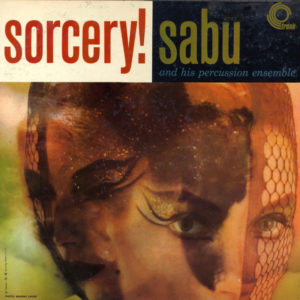It’s time to forge the second link in our jazz chain. What’s this ‘jazz chain’ you ask? Well, I’m taking a tour through the history of jazz, one album at a time, and each week’s album will be linked to the previous week’s selection by a common artist.
For example: last week the chain started with Art Blakey’s Orgy in Rhythm. One of the musicians from that album was Sabu Martinez who played percussion and provided the vocals for three of it’s tracks. This week we’re looking at Sabu Martinez’s album Sorcery!. Next week’s album will be lead by one of the the other musicians playing on Sorcery!.1I’ve already chosen the artist and album for next week, but let’s not get ahead of ourselves.
Sorcery! – Sabu Martinez – 1958
Now, I chose Sabu Martinez as the next artist to focus on because of his prominent place on Orgy in Rhythm as a vocalist and because I thought it’d be interesting to move from the drummer Blakey to a different kind of percussionist.2Specifically a conguera. I chose Sorcery! because I gravitate towards albums with SF/F related titles.3A thing that happens a lot in jazz. The most on-the-nose example being Ornette Coleman’s 1971 album Science Fiction. So I was going into my first listen without many expectations, other than it was likely to be another percussion-heavy affair, and was a little surprised when my first thought was: this sounds like more tracks for Orgy. I considered choosing something else, but this is supposed to be about broadening my jazz experience and that doesn’t automatically necessitate large leaps from one album to the next. Sometimes fleshing out one particular area of the field more can be just as rewarding.
So I listened and I did some poking around. Orgy in Rhythm came out in ’57. Sorcery! was released in ’58. Martinez played on two other albums with Blakey and his Jazz Messengers in ’57: Cu-Bop and Drum Suite. Both albums absolutely do have similar elements, though they also break out into a more lively, danceable and recognizable sort of jazz too.4Something quite at home in Martinez’ other albums of his own. Clearly Blakey and Martinez were in similar places around this time and I’d hazard they were influencing each other quite a bit.5Noticeably though, while Blakey has many credits as a “sideman” in the years Martinez was playing on his albums Blakey never appeared on Martinez’s albums. Likely this is because Martinez wasn’t incorporating drum sets of the sort Blakey played on his albums, but it does make me wonder whose music was influencing whose more.
But let’s get back to Sorcery!.
As I said, the tracks on this album absolutely feel like they could be on Orgy in Rhythm. The primary points of difference between the two albums are that Sorcey! doesn’t hit it’s high energy points at the same frenetic levels that Orgy does, and it lacks the fun interludes that Orgy needed to break up Blakey’s trademark power and energy. Sorcery! maintains a more cohesive experience by avoiding the extremes. It knows what it wants to be and it does it very well.6This shouldn’t be taken as criticism of Orgy in Rhythm. It is, in my opinion, the superior album.
So what does it want to be? The easiest way to sum it up might be to say the title is well chosen. From beginning to end these six tracks seek to cast a spell on you, to transport you to a place that does not exist in our modern physical world, and I think they largely succeed. There are no bad songs here and the opening “Aurora Borealis” is particularly good, as is the longest track “Milk Weed”. Perhaps because I’ve been listening to so much drum music between last week’s album and this though the thing I’ve been enjoying the most is the oboe playing, which is allowed to dominate the track “Moon Black” the loveliest and best the album has to offer.
Of course, the natural assumption might be that I would choose the player of that lovely oboe to highlight in next week’s installment of The Jazz Chain. Unfortunately, that will not be the case. Near as I can tell7Because finding artist credits for this album has proven particularly difficult, the oboe player is named Gene Allen. Unfortunately, the only Gene Allen I can find information on as a jazz player may not even be the same Gene Allen and doesn’t seem to have ever lead an album either. So instead we’re going with Cecil Payne, a baritone & alto saxophone player as well as a flutist who I can find credited several places as playing on this album, and we’ll be talking about his album Zodiac.

